In His Own Words: Chuck Jones on Music in Animation
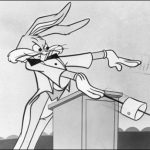
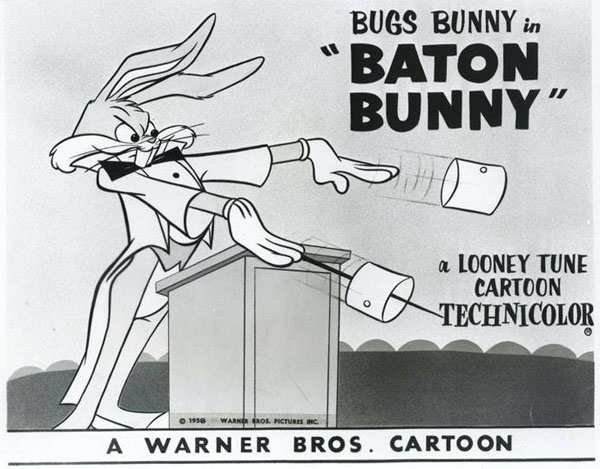
Suspended Animation #295

Chuck Jones in 1950
I once told him in his later years that he looked like a disreputable English professor, a description I repeated in one of my ASIFA newsletter columns, and he delighted in that reference and agreed with it. He certainly never hesitated to pontificate and go off on a tangent. As a result, his autobiography was often tough reading for me.
Hollywood Quarterly was a serious journal devoted to the study of film, radio and later television published between 1945 and 1957 published by The University of Calfornia Press overseen by a five person editorial board guided by advisors in the different genres.
In the July 1946 issue of Hollywood Quarterly, Jones authored a seven page essay entitled Music and the Animated Cartoon. Here is an excerpt from my files that you may never have seen previously.
 The animated cartoon, in its mature form, can be the most facile and elastic form of graphic art. Since the first Cro-Magnon Picasso hacked etchings on his cave wall every artist has longingly sought the ideal medium —one that would contain within its structure color, light, expanse, and movement. The animated cartoon can supply these needs.
The animated cartoon, in its mature form, can be the most facile and elastic form of graphic art. Since the first Cro-Magnon Picasso hacked etchings on his cave wall every artist has longingly sought the ideal medium —one that would contain within its structure color, light, expanse, and movement. The animated cartoon can supply these needs.
It knows no bounds in form or scope. It can approach an absolute in technical realism and it can reach the absolute in abstraction. It can bridge the two without taking a deep breath. The technical problems present in live action, when it tends toward the unreal or fantastic, are simply not present to the animator.
The transition of Dr. Jekyll to Mr. Hyde is workaday routine to the animator. He can do it and add three pink elephants to the transition. He can do it while stifling a yawn. In fact, he frequently does.
A red ant can grow to a golden elephant under his hand, a flying horse recede to a black pearl. He can create thunderstorms, tidal waves, flying carpets, talking hornets, dancing orchids, all with credibility, all with no technical obstructions.
Yet in spite of these potentialities the animated cartoon has been severely restricted in its growth. Its use as an educational device is a comparatively recent development, stimulated by wartime needs.
Culturally, the animated cartoon is in the toddling stage, as it is politically. It has made few profound statements about anything. Like all other motion pictures, it is dependent on a wide and highly diversified audience approval —the thing known in some quarters as “box office,” and “box office” in terms of animated cartoons is judged almost wholly by the degree of audible audience reaction.
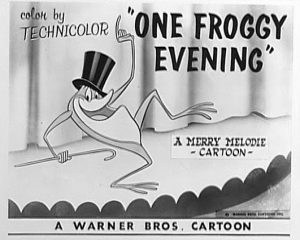 The appreciative chuckle, the pleased cluck, does not add up—in animation circles—to good “box office.” This has resulted in a wave of reaction throughout the industry against the type of cartoons known as “Rembrandts”; that is, any type of cartoon except those based on the “boff” or belly laugh.
The appreciative chuckle, the pleased cluck, does not add up—in animation circles—to good “box office.” This has resulted in a wave of reaction throughout the industry against the type of cartoons known as “Rembrandts”; that is, any type of cartoon except those based on the “boff” or belly laugh.
One producer asked his artists to use lots of purple in the backgrounds because, as he put it, “purple is a funny color.” Well, I think G-flat is a funny note. I mention these instances, not because I am unsympathetic with the producer’s viewpoint or wish to suggest that the imperative pressures of the box office can be disregarded, but because I believe that a deeper understanding of the aesthetic and cultural possibilities of the medium can serve to broaden its usage and increase its popularity.
My purpose here is the appraisal of one of these possibilities—the function of music in relation to the cartoon.
All cartoons use music as an integral element in their format. Nearly all cartoons use it badly, confining it as they do to the hackneyed, the timeworn, the proverbial. The average cartoon musician was a theater organist during the silent era and so William Tell takes quite a beating in the average cartoon. For some reason, many cartoon musicians are more concerned with exact synchronization or “mickey-mousing” than with the originality of their contribution or the variety of their arrangement.
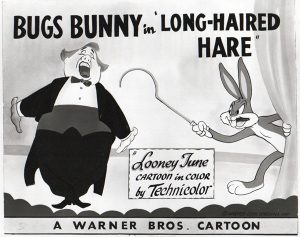 To be sure, many of the cartoons as they reach the musician are something less than inspirational, but most of them, even the best, gain less than they should from his contribution. I have seen a good cartoon ruined by a deadly score. If you can visualize Death and Transfiguration as a theme to Peter Rabbit, you get the idea.
To be sure, many of the cartoons as they reach the musician are something less than inspirational, but most of them, even the best, gain less than they should from his contribution. I have seen a good cartoon ruined by a deadly score. If you can visualize Death and Transfiguration as a theme to Peter Rabbit, you get the idea.
Nor is this a diatribe against the practicing musicians in the cartoon field; many are excellent and conscientious artists (among them Carl Stalling, Warner Bros.; Scott Bradley, MGM; Frank Churchill, Paul Smith, Larry Morey, and others for the Disney features and shorts), but many tend to underrate the medium and to disregard its musical potentialities.
Here are two examples of what I believe to be the nearly perfect wedding of music and graphics which occurs when the visual and auditory impacts are simultaneous and almost equal.
Both examples are from the picture Fantasia; both are bits. One consumed about four seconds in the Toccata and Fugue sequence. It pictured simply a ponderous, rocklike, coffin like mass that waddled into a murky background accompanied by a series of deep bass notes. I should not say “accompanied,” because this Thing was the music: to my mind there was no separation; the fusion of the auditory and the visual was perfect.
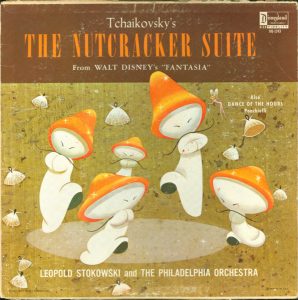 The second of my two instances represents, I believe, the happiest, most perfect single sequence ever done in animated cartoons, perhaps in motion pictures: the little mushroom dance from the Nutcracker Suite.
The second of my two instances represents, I believe, the happiest, most perfect single sequence ever done in animated cartoons, perhaps in motion pictures: the little mushroom dance from the Nutcracker Suite.
Here was an instance of almost pure delight; again, an entrancing blend of the eye and the ear in which I found the music itself personified on the screen. There was a personal quality to these sequences, too, that was generally lacking throughout the rest of the film.
It may be that if the makers of future Fantasias will be less concerned with the pageantry of their project and will search harder for the humanness of the music, we will have better films and better box office; for I believe that the mushroom dance has universal appeal, that it will go well in St. Jo and Walla Walla—as well as it will go in Hollywood or New York.
I believe that the best solution to interpretation of abstract music is to go along with it; that is, to be abstract graphically. Audiences may read into your drawings the thing they’ve been visualizing all the time.
 I don’t mean that you can throw a blob of ultramarine on the screen and hope thereby that the lady in the third row is going to find her dream prince, while the old gentleman in the right rear is mentally gulping flagons of sparkling mead.
I don’t mean that you can throw a blob of ultramarine on the screen and hope thereby that the lady in the third row is going to find her dream prince, while the old gentleman in the right rear is mentally gulping flagons of sparkling mead.
But there are some generally accepted symbols in art as in music. Just as the low note of a contrabassoon does not conjure in your mind “hummingbird,” a single scarlet line does not, in drawing, say “elephant.” These are definite things, yet it is possible to find abstract sounds and abstract images that are sympathetic.
We are dealing with a relatively new but immensely versatile and horizonless medium. The ideas suggested in this paper serve merely to suggest, or outline, a few possibilities from one viewpoint. Any imaginative person can easily elaborate on it. The animated cartoon as an artistic, educational, and entertainment medium is in its infancy. Its maturity depends on you.
* This article was originally published here


Comments
Post a Comment